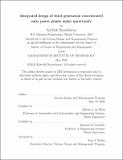| dc.contributor.advisor | de Weck, Olivier L. | |
| dc.contributor.advisor | de Neufville, Richard | |
| dc.contributor.author | Rajasekaran, Karthik | |
| dc.date.accessioned | 2022-08-29T16:13:02Z | |
| dc.date.available | 2022-08-29T16:13:02Z | |
| dc.date.issued | 2022-05 | |
| dc.date.submitted | 2022-06-28T20:28:11.840Z | |
| dc.identifier.uri | https://hdl.handle.net/1721.1/144807 | |
| dc.description.abstract | This research focuses on the Gen3 (3rd generation) solar tower CSP (concentrated solar power) variant. A methodology is introduced to evaluate two different approaches to deploying this technology - one is the conventional "build large" approach and the other is a "build modular" approach. Performance and cost models of the two different approaches are built and validated against industry data and then the two different approaches compete across three locations (Daggett CA, New Orleans LA, and Boston MA) and three different capacity factors (20%, 30%, and 40%). For these nine cases, the comparison between the two different approaches is first done with deterministic inputs and then with stochastic inputs for selected variables.
The results show that when the "build large" approach is compared against the "build modular" approach using deterministic inputs, the "build large" approach" is favored and has a NPV that is 5%-15% higher than that of the "build modular" approach for most of the nine cases, which aligns with the current industry belief that the "build large" approach is better due to economies of scale. However, when the same approaches are compared using stochastic inputs, the "build modular" approach is preferred over the "build large" approach. The ENPVs for the "build modular" approach are 20% higher than that of the "build large" approach while requiring 50% less initial capital than the "build large" approach. This reversal is driven primarily by the flexibility and the learning rate inherent to the "build modular" approach. By employing a "build modular" approach for this technology, a firm that is entering the CSP market could gain a competitive advantage over other firms in the CSP and renewable energy markets. | |
| dc.publisher | Massachusetts Institute of Technology | |
| dc.rights | In Copyright - Educational Use Permitted | |
| dc.rights | Copyright retained by author(s) | |
| dc.rights.uri | https://rightsstatements.org/page/InC-EDU/1.0/ | |
| dc.title | Integrated design of third generation concentrated solar power plants under uncertainty | |
| dc.type | Thesis | |
| dc.description.degree | S.M. | |
| dc.contributor.department | System Design and Management Program. | |
| mit.thesis.degree | Master | |
| thesis.degree.name | Master of Science in Engineering and Management | |
